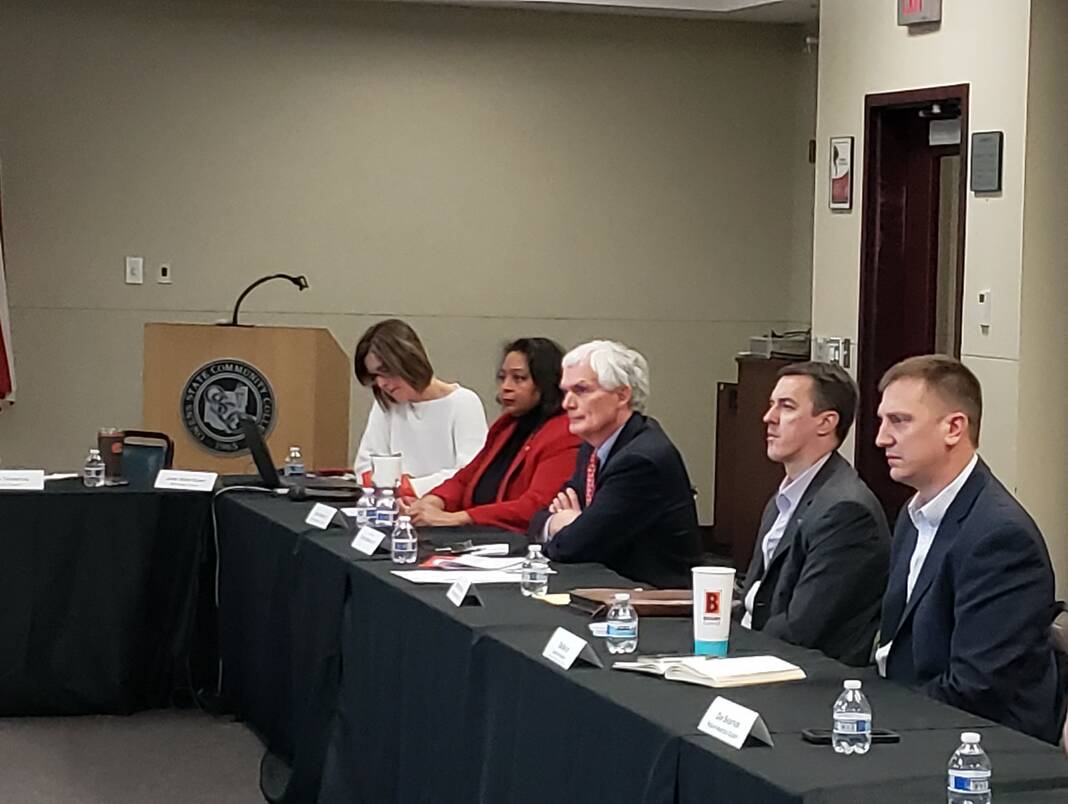
FINDLAY — Not only are local manufacturers looking for new employees from a shrinking pot, but they also need to figure out how to retain them.
Owens Community College hosted a workforce roundtable Friday on its Findlay campus to discuss how it can provide training for the region’s advanced manufacturing industry.
U.S. Rep. Bob Latta, R- Bowling Green, was in attendance as were leaders from First Solar in Perrysburg, Rosenboom Custom Crafted Cylinders in Bowling Green, and Cooper-Goodyear, Whirlpool Corporation and Freudenberg NOK, all in Findlay.
Owens President Dione Somerville said the college’s goal is to provide solutions to workforce development in the region while recognizing the importance of the talent along the I-75 corridor.
Latta, who is chairman of Congress’ communication and technology subcommittee, said there are 76,000 manufacturing jobs in his 5th District.
A concern he has heard over and over in the last decade is there aren’t enough people to fill job vacancies.
“Companies out there are so desperate for people, that they all say the same thing: We will take a person off the street that has absolutely no experience of what we need them to do, and we’ll invest five months in that person to try to get them up to speed,” Latta said.
The challenge after getting people trained is getting them to stay, he said.
In Wood County, construction is the leading industry. In Hancock County, it is plastic and rubber products manufacturing.
Wood County just posted its lowest unemployment rate of record, around 2.6%, so that translates to less than 2,000 people unemployed in the county, said Wade Gottschalk, executive director of the Wood County Economic Development Commission.
“Obviously the demand is much higher,” he said.
Quinton Roberts, dean of Workforce and Community Services at Owens, said Owens is ready to meet the needs industry has to train the workforce in place.
Industry 4.0 is the fourth industrial revolution after steam engines, the production line and digitization. It includes robots and numerical controlled machines, he said.
“The whole idea is everything is moving toward a more automated work force, which requires a more highly skilled workforce,” Roberts said.
These skills typically aren’t learned in high school, and an associate’s degree or an apprenticeship program will be needed, he said.
Owens offers partnerships and collaborations in order to be flexible to meet company’s needs, and as a result, companies are investing to see their employees be successful, Roberts said. If Owens doesn’t currently offer an area of training, they can get it, he said.
As an example, Roberts said Owens worked with First Solar on skills that employees need, and graduated 32 students with an industrial mechanics certificate for the company.
“But will they stay? The truth is, if you don’t invest in them, they certainly won’t stay,” he said.
Jason Mesteller, with First Solar, said he rarely finds semiconductor and device physics being offered in a curriculum.
“That is advanced manufacturing,” he said.
There are 52,791 open jobs in Northwest Ohio with 10,000 unemployed. On those openings, 5,820 are in manufacturing, said Jamie Beier Grant, director of economic development planning with the Columbus-based Montrose Group LLC.
Sixty percent of today’s jobs will be impacted by new technologies and 74% of hiring managers reported a skills gap in the current labor market, she said.
She said that the 3,000 jobs coming with the Intel plant being built in central Ohio, could affect Northwest Ohio.
Owens can continue to work with businesses, to understand what the workforce needs are and build a curriculum to meet those needs, Grant said.
The pandemic accelerated automation in industry, said Roy Schroeder with Freudenberg NOK.
They need help with educating the engineer who was trained 30 years ago, to learn how to work on today’s machines, he said.
Jeffrey Rains, with Whirlpool, said cross training on the current technology is necessary as a highly educated engineer can’t be the only person who can respond to issues on third shift.
All that matters is more people right now, and that outweighs the need for people to learn about automation – although that is the direction they are heading, he said.
Tricia Valasek, with Raise the Bar Hancock County, said they took teachers on tours of local manufacturing facilities last summer and many had no idea what was being made in their own community.
They were also impressed with how exciting these careers can be, Valasek said.
Retention efforts also need to be considered when hiring into manufacturing.
First Solar added about 700 people but retained only around 500, Mesteller said.
Mary DeWitt, with Ohio Means Jobs Wood County, said child care, transportation and benefits can affect a worker’s decision to change jobs. Wood County has started a retention project to try to figure out what the issues are and how they can be addressed.
After the meeting, DeWitt said she was pleased for the potential collaboration between businesses and training providers.
“I think that skills gap is something is something we need to focus on,” she said.
In Wood County, they are really starting to engage the younger population to get them exposed to different careers, including manufacturing, DeWitt said.
Somerville said some fast food businesses now utilize an app where employees can sign up for shifts they can work, and that is appealing even if it pays less.
When an employee faces challenges, it’s easier to go somewhere else than try to solve the problem, she said.
Somerville said she is looking forward to further discussions.

